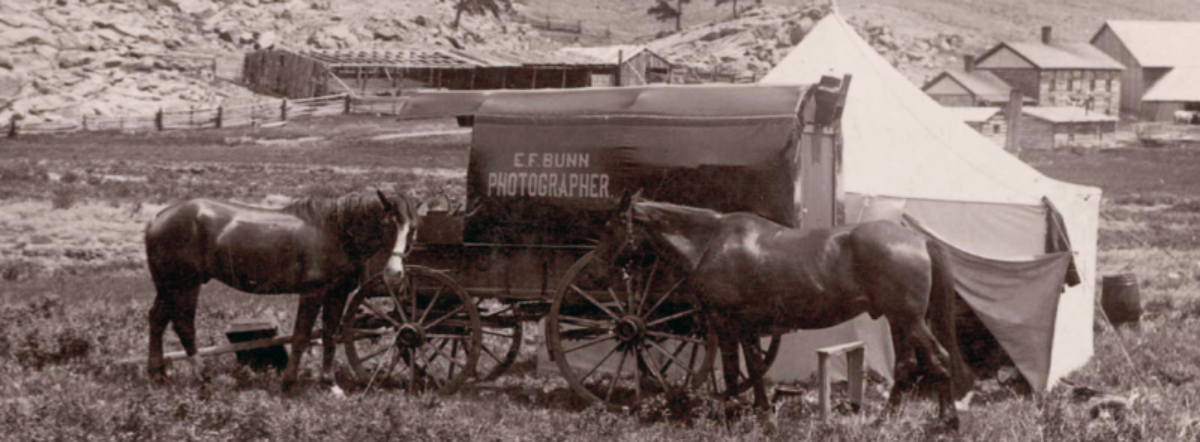March is Women’s History Month. More than eighty women worked in Colorado’s photographic industry during the 19th century, as photographers, retouchers, colorists, and print mounters. Biographical information about these women and examples of their work are often hard to find.
Earlier this year, I received a research grant from the The Peter E. Palmquist Memorial Fund for Historical Photographic Research that will allow me to travel to libraries and museums in distant Colorado locales to learn more about the photographers, both men and women, working in their communities. I am very grateful for this support and will share my findings in this blog, so stayed tuned.

Fortunately, Julia Skolas, is one of the better known woman photographers in Colorado. She was born to Norwegian immigrants in Wisconsin on May 14, 1863. She grew up with her nine siblings on a farm outside Cottage Grove, WI, a short distance east of Madison.
In the early 1890s, single and about thirty years of age, she moved nearly one thousand miles from her family and home to Denver. On December 31, 1892, she attended Denver’s annual Norwegian New Year’s Eve ball. (Rocky Mountain News, Jan. 1, 1893, p. 2, c. 1) It is very likely that she was living in Denver at this time, but she doesn’t appear in the city directory until 1894, with no occupation listed. Her relaxed and unconventional pose in the portrait by Charles A. Nast makes me wonder if perhaps she learned photography from him. Nast operated at the 1624 Curtis Street address between 1891 and 1893, which matches the time Skolas arrived in Denver. Unfortunately, no records exist to confirm my suspicions.

By 1896, Skolas lived in Colorado Springs, where she ran a photographic studio for a decade. She was a member of the Monday Progress club, a women’s social and educational organization. The members would give talks on current events and the arts. The Colorado Springs Gazette (Jan. 29, 1905, p23) reported on a debate about “Labor organizations,” with Mrs. C. L. Smith of Manitou, taking the union side, Skolas, the non-union. In 1903, at the club’s annual day-long picnic, held among the wildflowers in North Cheyenne Canon, “Miss Skolas…presented each guest with a puzzle, which proved to be a little sketch illustrating the name of the individual.” (Colorado Springs Gazette, June 28, 1903, p. 16, c.6) She was also a founding member of the Colorado Springs Badger club, a group of ninety-one residents of the Springs who claimed Wisconsin as their former home.

In 1906, Skolas sold the copyright of her photograph “Madonna and Child” to the Tabor Prang Art Company, a well-known producer of art prints based in Springfield, MA. Prang continued to offer this print for sale well into the 1920s. Skolas submitted a several photographs to the Library of Congress’ Copyright Office between 1907 and 1912, but they do not appear in the Prints & Photographs Online Catalog. In 1911, James Alexander Semple, singled out Skolas for inclusion in his book Representative Women of Colorado.
In 1907, Skolas moved her business to the mining town of Cripple Creek. She photographed the interiors and exteriors of mines extensively, even making and selling real photo postcards that were just gaining favor as souvenirs. She remained there until around 1920, leaving many of her glass plate negatives behind.

In her sixties, Julia moved temporarily to Madison, Wisconsin, but she was back in Denver by 1924, working as a photographer. She placed the following advertisement in the January 18, 1925 Denver Post: “ONE 8 x 10 view camera, 1 8 x 10 portrait lens, cheap. Skolas, Apt. 29 1/2 1720 Logan.” signaling the end of her photographic career.
In later years she worked as a milliner, candle maker, and in candy sales. This list of careers may show how difficult it was for an older woman to make a living. By 1931 she had returned to Madison, Wisconsin, where she lived until the end of her life. She died of a heart condition on December 31, 1934, and is buried at the West Koshkonong Lutheran Church Cemetery, in Stoughton, Wisconsin.
Additional resources:
See more Julia Skolas photographs online at the Pikes Peak Library.
Here’s a podcast that features information about Julia Skolas and a few other early Colorado women photographers.
Bathke, Nancy and Brenda Hawley. “Searching for the Early Women Photographers of the Pikes Peak Region.” in Film and Photography on the Front Range. Colorado Springs: Pikes Peak Library District, 2012.
Thank you to Beverly Brannan, recently retired curator of photography at the Library of Congress, Prints & Photographs Division, for editing this post.

Thanks for this post. I really enjoyed it and look forward to reading more.